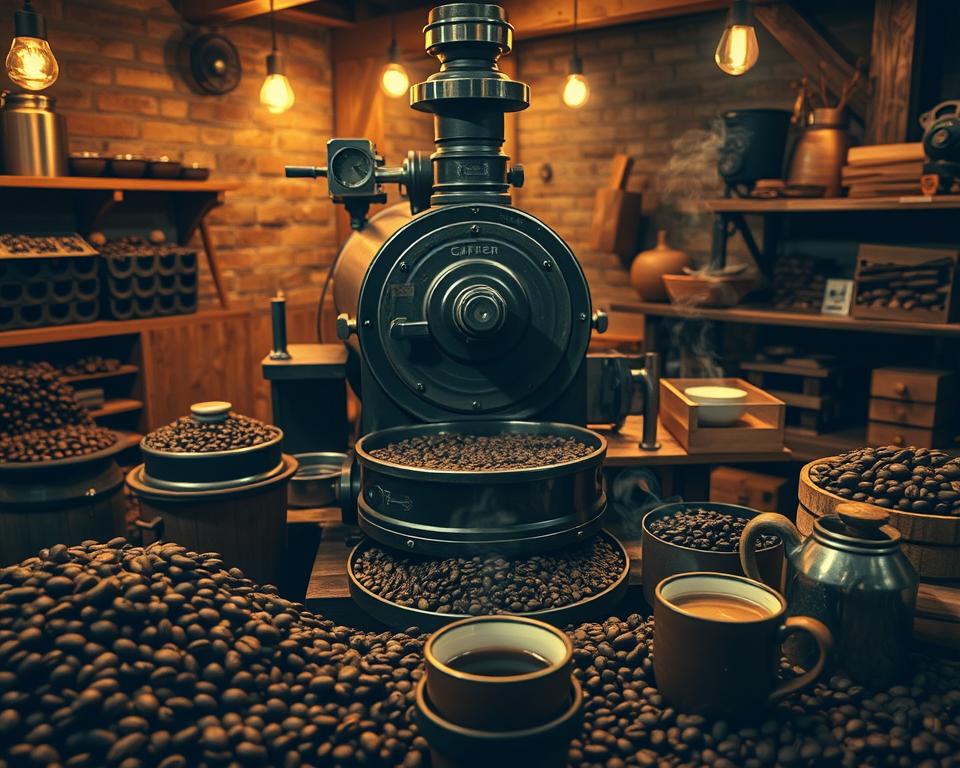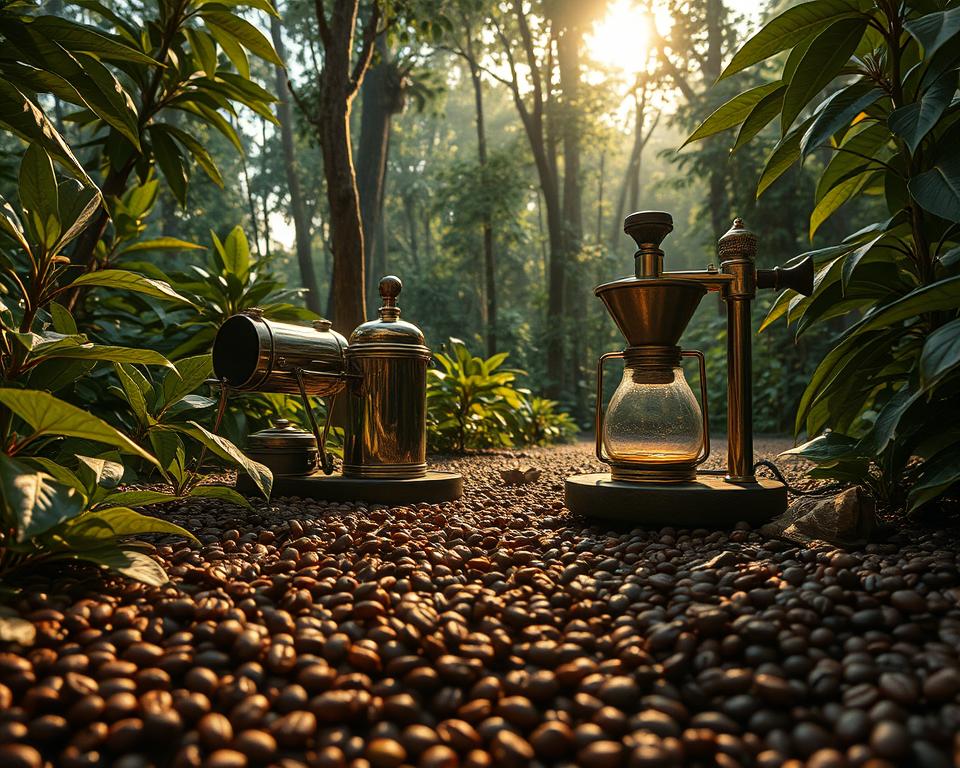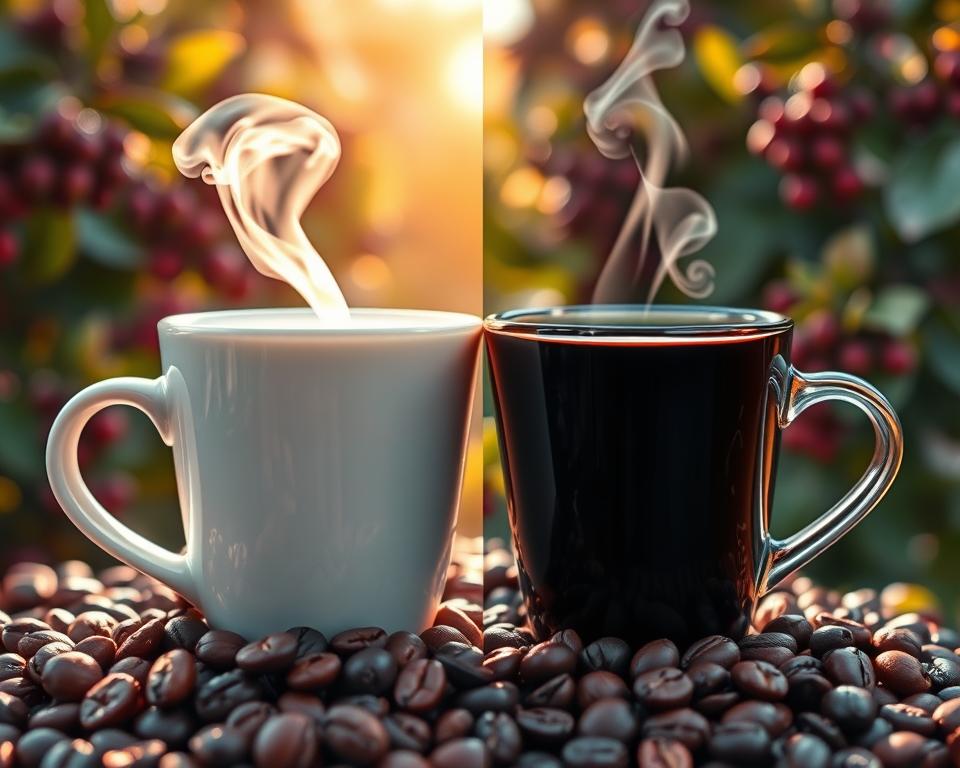Artisan coffee focuses on quality, flavor, and the art of roasting. Unlike bulk roasting, artisan roasters prefer small batches. This allows them to meticulously control every step. Because of this, their coffee has rich flavors and unique traits.
The world of handcrafted coffee offers a lot of choices. Prices range from $800 per pound for Panama Geisha coffee to more affordable options. Small-batch techniques keep the beans’ flavors intact. Every bean, like the fruity Excelsa or woody Liberica, retains its distinct taste thanks to artisan roasters.
Artisan roasters, such as SonRise Coffee Co., are praised for their commitment to quality and sustainability. They produce standout coffee by paying attention to details. This method includes precise temperature controls and different roasting stages. Each batch is carefully made, showing true coffee artistry.
Understanding Artisan Coffee Roasting
Artisanal coffee roasting is all about the art of making great coffee. Every bean is carefully treated to show off its unique taste. This careful approach makes artisan roasting different from big commercial methods.

What Sets Artisan Roasting Apart
Quality is key in artisan coffee roasting, unlike mass production. Artisan roasters work by hand, not using big machines. They focus on the art, making sure each batch is special.
The Role of Small Batches
Roasting coffee in small batches is very important. It lets roasters control the roast perfectly. Whether it’s a light or dark roast, each batch comes out just right, full of flavor.
Focus on Quality and Flavor
Artisan roasting really cares about quality and taste. Roasters pay attention to every detail of the beans. This hard work leads to a range of flavors, showing off their skills. It’s this careful craft that makes artisan coffee stand out.
Exploring Artisan Coffee Roasting Methods
Artisan coffee roasting is a journey of flavors. It starts from picking the right coffee beans to controlling the roast temperature. Every step matters to make your coffee unique.
The Importance of Bean Selection
Selecting coffee beans is the first step. High-quality beans from dedicated producers lead to complex flavors. Mikko Coffee Roasters, for example, picks beans for their depth. The origin of beans is crucial too, since different regions have unique tastes. This careful choice is vital for the success of artisanal roasting.
Temperature and Timing Control

Controlling the temperature is key. A rise between 5 and 9 degrees Celsius per minute is recommended. Precision in this phase affects the aroma and taste. Keeping the temperature consistent ensures an even roast.
Stages of the Roasting Process
Knowing the roasting stages is vital for artisanal roasting. There are several important phases:
- First Crack: A crucial transformation where beans spend about 23% of their roast time.
- Development: Beans develop their rich flavors, making up around 45% of the roast time.
- Cooling: After roasting, beans cool quickly to stop the process and avoid over-roasting.
Maintaining a weight loss of around 15.5% during these stages is good for flavor and texture.
Handcrafted Techniques
Artisan roasting is an art, involving handcrafted techniques. Roasters adjust settings by hand and use their senses for feedback. Mikko Coffee Roasters, for example, uses Loring roasters for control. This hands-on approach allows for flavor experimentation.
Safety is important when roasting. Always work in ventilated areas and wear protection. Don’t let mistakes discourage you. Workshops in cities like New York City, San Francisco, and Seattle can help improve your skills.
The Impact of Equipment on Roasting
The world of coffee roasting is complex. It greatly depends on the equipment used. Whether you use old-style tools or the latest technology, your choices greatly affect the coffee’s taste. Traditional tools like hand-crank roasters bring a unique touch to the process.
On the other side, modern technology brings precision to roasting. Tools like fluid-bed roasters improve heat transfer. The Typhoon 5 Shop Roaster is a good example of this, offering even roasts every time. It allows roasters to closely control the process for consistent results.
Modern equipment also includes efficient chaff fans for better airflow. This helps avoid too much roasting and keeps the flavor smooth. Even small roasters can now track and control the roasting process in detail, thanks to new technology.
When setting up new roasters, it’s key to have enough space and the right setups. Training for staff is also essential. Both old-school and new roasting tools have their benefits, meeting the needs of coffee lovers everywhere.
Flavor Differences Between Artisan and Commercial Roasting
Coffee roasting techniques deeply affect the flavor profile of the brew. Artisan vs. commercial roasts offer distinct tastes and aromas. Knowing these differences can make every cup of coffee more enjoyable.
Roasting Profiles and Their Effects
Artisan roasters focus on small batches for better control. They adjust roasting profiles to create different flavors. Light roasts bring sweetness and acidity, highlighting the bean’s natural taste. Darker roasts, however, are smoky and bitter, appealing to many.
Various roasting levels can unveil flavors like fruits, nuts, and spices. Exploring these profiles allows coffee lovers to discover a spectrum of tastes.
Nuanced Flavors in Artisan Roasts
Artisan roasts stand out for their complex flavors. Roastmasters tweak each batch to highlight unique traits. This results in coffees that reflect their origin, like Ethiopia, Tanzania, or Colombia. Artisan-roasted coffee invites drinkers on a rich taste journey.
Consistency in Commercial Roasting
Commercial roasts aim for consistency and efficiency. Large-scale roasters use automation to ensure uniform flavor. This method suits those who prefer familiar tastes. Commercial beans generally taste robust and bitter, appealing broadly.
The Role of Specialty Coffee Roasters
Specialty coffee roasters blend artisan and commercial methods. They focus on delivering top-quality coffee with consistency and control. They mix advanced technology with artisan skills to enhance flavor profiles. This ensures the highest quality in every cup. Let’s explore their impact on the coffee world more closely.
Artisan vs. Commercial: Pros and Cons
Artisan roasting focuses on small batches and rich flavors. It involves a hands-on approach, appealing to coffee lovers. But, it has lower scalability and higher costs. Commercial roasting, meanwhile, ensures consistency and large-scale production. Yet, it sometimes sacrifices flavor and craftsmanship. Specialty coffee roasters find a middle ground. They fuse precise roast profiling with increased batch capabilities.
Key Benefits of Specialty Coffee Roasters
Specialty coffee roasters offer many advantages, including:
- Advanced Technology: They use automation and AI for roast and flavor control.
- Superior Bean Selection: Their beans are chosen for unique flavors and aromas.
- Focus on Freshness: Keeping coffee fresh is crucial. Brands like Flat Cap Coffee roast beans to order. This ensures maximum freshness and an unforgettable experience for each cup.
- Enhanced Flavor Profiles: These roasters focus on quality and flavor. They create indulgent experiences that surpass standard commercial roasts.
Supporting Sustainability and Ethics
Specialty coffee roasters are committed to sustainability and ethical sourcing. Roasters like Big Island Coffee Roasters and Flat Cap Coffee support fair farmer pay and safe work conditions. They also practice environmental consciousness. This commitment means your coffee is not just enjoyable but also responsible.
They help ensure the coffee journey respects quality, community, and the environment. To learn how to make cold brew and nitro coffee at home, check this DIY guide.
How Do Artisan Coffee Roasting Techniques Differ from Small Batch Coffee Roasting?
Artisan coffee roasting techniques focus on quality and individuality, allowing for precise control of flavor profiles. In contrast, small batch coffee roasting emphasizes consistent, high-quality results on a smaller scale. Both methods excel in their own way, underlining the importance of understanding the impact of small batch roasting on the overall coffee experience.
Conclusion
Artisan coffee mastery combines skill, precision, and passion. We’ve learned that the right techniques can greatly improve coffee roasting. Key steps include controlling temperature and time, using top-quality beans, and carefully watching the roast.
Specialty coffee roasters focus on quality, sustainability, and ethical sourcing. They get beans from trusted growers and offer personalized service. Their commitment to fairness improves the coffee culture for everyone.
In the end, roasting aims for perfection, whether using old or new methods. Trying different beans, watching temperatures closely, and taking notes lead to new discoveries. This dedication ensures a premium coffee experience in every cup, celebrating the vast skills and commitment involved.
FAQ
What is artisan coffee roasting?
Artisan coffee roasting focuses on quality and hands-on techniques. It uses smaller batches. This allows roasters to bring out unique flavors, making your coffee experience better.
How does artisan roasting differ from commercial roasting?
Artisan roasting cherishes artistry and taste, focusing on small batches and manual methods. In contrast, commercial roasting aims at big-scale production, valuing efficiency and consistency. This often leads to simpler tastes.
Why are small batches important in artisan coffee roasting?
Small batches give roasters control to perfect the roast. This focus brings out the coffee’s best flavors and consistency. It highlights what’s unique about each bean.
What role does quality play in artisan coffee roasting?
In artisan roasting, quality is everything. It means carefully choosing beans and controlling the roast with skill. This way, artisan roasters ensure your coffee is the best it can be.
Why is bean selection important in artisanal roasting?
Different beans have different flavors. Picking the right beans is key to great coffee. It lets roasters match their skills to the beans, enhancing taste.
How do temperature and timing affect the roast?
Getting the temperature and timing right is crucial. It affects how the flavors develop. Master roasters adjust these to showcase each bean’s best qualities.
What are the stages of the roasting process?
Roasting includes drying, browning, and developing. Each step needs precise heat adjustments. Roasters need deep knowledge to get the flavors just right.
What handcrafted techniques are used in artisan roasting?
Artisan roasters rely on their senses to adjust the roast. They use smell and sound to get the perfect flavor. This personal touch sets their coffee apart.
How does equipment impact the roasting process?
The right tools are key for consistent high-quality coffee. They can be traditional, relying on the roaster’s skill, or high-tech, for precise control. This makes good coffee whether in small or large batches.
What are the flavor differences between artisan and commercial roasting?
Artisan coffee has richer, more complex flavors. That’s because of its careful, small-batch approach. Commercially roasted coffee, though consistent, usually misses these deeper taste notes.
What are roasting profiles, and how do they affect flavor?
Roasting profiles shape a coffee’s taste. They’re plans for temperature and time. Artisan roasters experiment with these to unlock delicious flavors in the beans.
What benefits do specialty coffee roasters offer?
Specialty roasters combine technology and flavor focus. They make consistent, excellent coffee. Plus, they’re big on sustainability and ethics, adding value to their coffee.
How do specialty coffee roasters support sustainability and ethics?
Specialty roasters support fair and green practices. They choose beans that are traded fairly and grown eco-friendly. It makes their coffee supply chain responsible and ethical.




